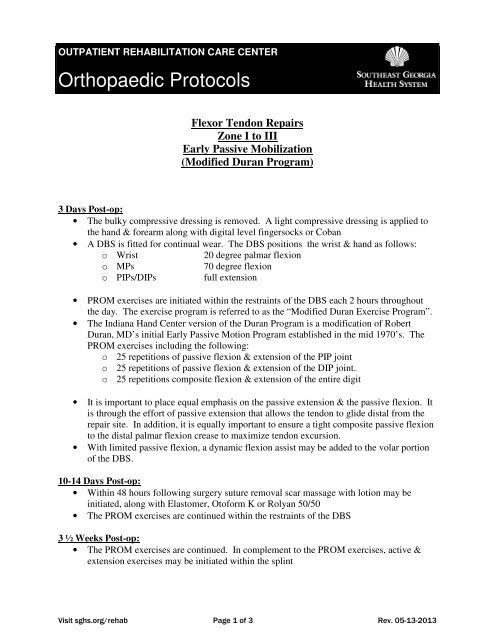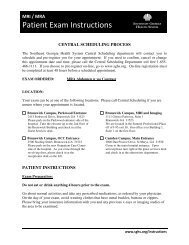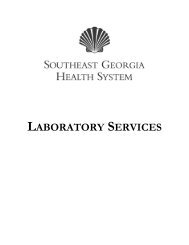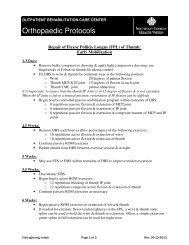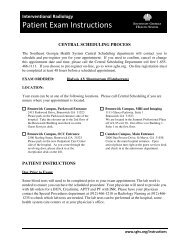You also want an ePaper? Increase the reach of your titles
YUMPU automatically turns print PDFs into web optimized ePapers that Google loves.
OUTPATIENT REHABILITATION CARE CENTER<br />
<strong>Orthopaedic</strong> <strong>Protocols</strong><br />
Flexor Tendon Repairs<br />
Zone I to III<br />
Early Passive Mobilization<br />
(Modified Duran Program)<br />
3 Days Post-op:<br />
• The bulky compressive dressing is removed. A light compressive dressing is applied to<br />
the hand & forearm along with digital level fingersocks or Coban<br />
• A DBS is fitted for continual wear. The DBS positions the wrist & hand as follows:<br />
o Wrist<br />
20 degree palmar flexion<br />
o MPs<br />
70 degree flexion<br />
o PIPs/DIPs full extension<br />
• PROM exercises are initiated within the restraints of the DBS each 2 hours throughout<br />
the day. The exercise program is referred to as the “Modified Duran Exercise Program”.<br />
• The Indiana Hand Center version of the Duran Program is a modification of Robert<br />
Duran, MD’s initial Early Passive Motion Program established in the mid 1970’s. The<br />
PROM exercises including the following:<br />
o 25 repetitions of passive flexion & extension of the PIP joint<br />
o 25 repetitions of passive flexion & extension of the DIP joint.<br />
o 25 repetitions composite flexion & extension of the entire digit<br />
• It is important to place equal emphasis on the passive extension & the passive flexion. It<br />
is through the effort of passive extension that allows the tendon to glide distal from the<br />
repair site. In addition, it is equally important to ensure a tight composite passive flexion<br />
to the distal palmar flexion crease to maximize tendon excursion.<br />
• With limited passive flexion, a dynamic flexion assist may be added to the volar portion<br />
of the DBS.<br />
10-14 Days Post-op:<br />
• Within 48 hours following surgery suture removal scar massage with lotion may be<br />
initiated, along with Elastomer, Otoform K or Rolyan 50/50<br />
• The PROM exercises are continued within the restraints of the DBS<br />
3 ½ Weeks Post-op:<br />
• The PROM exercises are continued. In complement to the PROM exercises, active &<br />
extension exercises may be initiated within the splint<br />
Visit sghs.org/rehab Page 1 of 3 Rev. 05-13-2013
Flexor Tendon Repairs Zone I to III Early Passive Mobilization<br />
4 Weeks Post-op:<br />
• NMES may be added to the therapy after the patient has been performing active flexion<br />
exercises for 3-5 days.<br />
• Ultrasound may be added to the therapy if a dense scar is present &/or limited tendon<br />
excursion is a concern<br />
4 ½ Weeks Post-op:<br />
• The DBS is removed each hour or 2 to begin AROM exercises outside the splint<br />
• The exercises include;<br />
o Wrist & finger flexion followed by wrist & finger extension<br />
o Composite fist followed by MP extension with the IP joints flexed, followed by IP<br />
extension<br />
o Composite fist with wrist extension & flexion<br />
5 ½ Weeks Post-op:<br />
• The DBS is discontinued<br />
• The AROM exercises described at 4 ½ weeks are continued patient education is vital.<br />
The patient must understand that a tight sustained grip with or without weighted<br />
resistance greatly increases the risk of rupture during the early healing of the flexion<br />
tendon repairs.<br />
• Extension splinting may be initiated in full active extension, if limited PIP extension is<br />
present. Preferably, the splint is worn at night only. During the day, it is recommended<br />
to buddy tape the involved digit to an adjacent digit for protection.<br />
6 Weeks Post-op:<br />
• Passive extension exercises are initiated. Blocking exercises may be initiated to the PIP<br />
joint & separately to the DIP joint. Note: Blocking is not permitted to the small finger.<br />
It has been the experience of these authors that blocking to the PIP joint & in particular,<br />
the DIP joint if at relatively high risk for rupture. Therefore, the authors do not perform<br />
blocking to the DIP joint of the small finger – no exception.<br />
• Dynamic extension splinting may be initiated if a PIP joint flexion contracture develops.<br />
8 Weeks Post-op:<br />
• Strengthening may be initiated to the hand beginning with putty or a hand exerciser &<br />
progressing to hand weights or equipment such as the BTE. Note: No heavy use of the<br />
hand is allowed at this time.<br />
10-12 Weeks Post-op:<br />
• Patient may begin to use the involved hand in all activities of daily living.<br />
14-16 Weeks Post-op:<br />
• Heavy, weighted resistance to the hand & extremity is permitted after 14-16 weeks.<br />
Visit sghs.org/rehab Page 2 of 3 Rev. 05-13-2013
Flexor Tendon Repairs Zone I to III Early Passive Mobilization<br />
Considerations:<br />
• The greatest achievements in ROM are obtained between 3 ½ & 7 ½ weeks. Therefore, it<br />
is important to emphasize to the patient active participation in the therapy program during<br />
the critical 4 weeks. Patients will continue to make gains though for up to 6 months by<br />
using their hand normally.<br />
• Digital nerve repairs, in conjunction with the flexor tendon repairs, may require<br />
positioning the PIP joint initially in 30 degrees of flexion & gradually increasing<br />
extension from 3 to 6 weeks. If the surgeon can report that the digital nerve repaired<br />
without tension this is ideal for allowing full passive excursion of the tendon.<br />
• For PIP joint flexion contractures to the small finger, it is highly recommended to initiate<br />
an extension splint between sessions & at night. There is a greater propensity for a<br />
flexion contracture to be difficult to resolve at the small finger, especially when the<br />
laceration is located at the PIP joint volar plate.<br />
Visit sghs.org/rehab Page 3 of 3 Rev. 05-13-2013


